
As we worked on pulling together this third installment of our review of U.S. InsurTech startup financials, we were reminded of the scene from “The Princess Bride” in which a masked man in black follows Inigo Montoya and his accomplices across the sea and up the Cliffs of Insanity.
Executive Summary
In April, Matteo Carbone and Adrian Jones presented overall loss ratio, expense ratio and combined ratio results from statutory filings of the three InsurTech carriers—Lemonade, Root and Metromile—finding poor underwriting results for the trio in 2017. In this update, the authors take a look at the insurers’ second-quarter 2018 numbers.While the mighty giant Fezzik embarks on the climb first, with Montoya and others hanging on his shoulders, the masked man catches up to the group and starts climbing the same rope beneath them.
“He’s gaining on us,” says Montoya, watching the masked man approach the cliffs. “Inconceivable,” says Vizzini, angrily rebuking the giant for failing to live up to his legendary reputation.
While the lumbering incumbents in the insurance industry are powerful giants and have a head start on the climb, they are also carrying lots of weight. Voilà. Startup vs. incumbent. (Watch the YouTube clip here.)
The venture-backed full stack U.S. InsurTech startups continued to gain in the second quarter through rapid premium growth and moderately lower underwriting losses. They have yet to show the ability to win at a sword fight, battle of wits, ROUS attack—or to generate a sustainable loss ratio under 100.
 For more information on where our data comes from and important disclaimers and limitations, see the 2017 edition of this series of articles.
For more information on where our data comes from and important disclaimers and limitations, see the 2017 edition of this series of articles.- Growth rates remain robust but may be slowing a bit.
- Gross loss ratios are generally stable or improving slightly but still unsustainable.
- Industry veterans are outperforming the newbies on loss ratio but not premium growth.
- Still several years to become scale insurers.
- Reinsurers continue to subsidize losses.
- Executive compensation appears to be as expected—probably mostly in stock.
As before, we respect the management teams highly and admire these companies for earning the right to call themselves an “insurance company.”
To date we have tracked the three independent P/C startups most commonly associated with the label “InsurTech”: Lemonade, Metromile and Root. This quarter we’ve also looked at four subsidiaries of larger companies with a direct or InsurTech focus.
(Editor’s Note: A longer version of this article, previously published on the LinkedIn pages of the authors, Matteo Carbone and Adrian Jones, includes a description of newly licensed Next Insurance, which wrote no premium. This shorter version is republished here with permission of the authors. For more on Next, see this related Carrier Management article in which CEO Guy Goldstein explains why the company decided to move from a digital agency to a licensed carrier structure: “InsurTech Next Insurance Transforms From Digital Agency to Carrier” )
Overall Results
Here is a summary of the second-quarter 2018 statutory financials of three venture-backed insurance companies. More quarterly details on each of the venture-backed companies is provided separately here. (Related article: “Second-Quarter 2018 Financial Details for Lemonade, Root and Metromile“)
And here are the four subsidiaries of big companies that are selling direct or have a claim on being an InsurTech. These companies often depend on parents for reinsurance and infrastructure, so we show mainly the gross figures.
- Growth rates remain robust but may be slowing a bit.
Are there issues on the customer acquisition, or are carriers focusing more on underwriting profitability?
Absolute growth was led by Root, which nearly doubled its quarterly gross premium written in three months. Our composite grew at 37 percent quarter-over-quarter, but most of the companies had their slowest or second-slowest quarter in the last six.
Is this a slight slowing trend? Maybe.
Some of the carriers may be seeing seasonal effects. If the pace of growth is really showing the first signs of slowing and not just a blip, the question is whether the slower growth is despite insurers’ efforts to grow or if they are deliberately focusing on profitability.
The CEOs of Root and Lemonade have hinted that they are focusing more on underwriting (here, here). So is this affecting growth rates? (Related articles: “InsurTech Carrier CEO Explains Poor 2017 Results; Fields Questions on Reddit“; “The Good and the Bad at Lemonade“)
Here is a point/counterpoint. Decide for yourself and add your thoughts in the comments.
Point: InsurTechs are finding growth more difficult
- Early adopters of direct insurance may already have been won. Consumers with a high propensity to buy online may be located in the states that carriers chose first, and future customers are harder to win.
- It may be harder to sell the value proposition than expected, particularly if underwriting is being tightened and differentiation is narrowing (e.g., Lemonade’s giveback declined from 10 percent of premium in 2017 to a less-compelling 1.6 percent this year.)
- Retention rates may be less than expected—either because customers defect or the carrier nonrenews unprofitable customers.
- Focusing on state expansion, team growth or fundraising distracts management.
Counterpoint: InsurTechs could grow faster but are throttling growth to focus on profit
- It is unlikely that companies with near-zero brand recognition have penetrated even a fraction of potential customers.
- Startups, their investors or their regulators may have realized that early customers were attracted to unsustainably low prices and produced high loss ratios. As they learn more about their customers, startups are being tougher on underwriting and are raising prices in new state filings, meaning they turn away more potential customers through price or declining the application. Lemonade has admitted as much. See page 594 of their recent Oregon filling for this nugget:

The LCMF is a Loss Cost Modification Factor, and higher LCMFs may indicate higher pricing. In spot-checking some of Lemonade’s recent filings, it is still filing a $5 minimum rate but pricing higher than incumbents such as State Farm in certain zones, perils, etc. The company’s frequency being higher than average could be a function of (1) a bot-driven claims system inviting fraud, (2) having shlimazels for customers, (3) problems with the coverage or form, or (4) a sign that the behavioral economics assumptions aren’t working as intended.
Recall Lemonade saying:”If you tried to create a system to bring out the worst in humans, it would look a lot like the insurance of today…We’ve spent recent years deepening our understanding of honesty and trust…Lemonade aims to reverse the adversarial dynamics that plague the industry, transforming both the economics and experience of insurance.”
What do you think? Contact us directly or on social media with your comments. (Editor’s Note: A version of this article was previously published on the LinkedIn pages of the authors, Matteo Carbone and Adrian Jones, where many readers have commented already.)

Focusing on the protagonists of our previous analysis Bigger and Redder, Root’s extraordinary growth means it has opened a big gap on Lemonade and is closing the gap with Metromile. This dynamic has helped Root achieve unicorn status with the last $100 million round of funding at the iconic $1 billion valuation.
Root is not the first insurer to test a “try before you buy” (TBYB) approach based on an app, but it is the first insurer in the world to build a sizable portfolio that way. Will Root succeed where others have abandoned their efforts or chosen different approaches such as usage-based pricing or discounts at renewal?
We commend Root for hitting the symbolic unicorn status so quickly. It appears to have a few years of runway to prove its model. By the time of an exit for the most recent investors, we believe that Root will be evaluated in greater part on the traditional KPIs that we look at in our analysis.
A few weeks ago, Bain Capital—we are Bain & Company alumni—offered $1.55 billion to buy Esure, a P/C insurer (mainly motor) selling online in the U.K. Esure wrote £880 million (annualized) premium in the first half of 2008 (or about US$1.1 billion)—and did so at a profit. Looking very simply at price-to-sales ratio (though we prefer ROE and price-to-book), Esure sold a bit over 1.4-times, which simplistically corresponds to $700 million of premium for a valuation of $1 billion.
Investors will need Root’s management to continue to grow rapidly. Root’s second-quarter 2018 run-rate is $60 million. Whether it can do so, and achieve profitability along the way, will be a bellwether for demonstrating if current valuations are a bubble or smart bets are on a rapidly changing industry.
Root’s $1 billion valuation should cause companies in low-margin commodity lines like home/renters and auto who are operating as MGAs to consider becoming a carrier. One of the strongest arguments for being an MGA, not a carrier, is that MGAs are more highly valued because they trade on a multiple of earnings rather than book value. For the time being, the most valuable recent startups in insurance underwriting appear to be carriers, not MGAs.
Looking abroad, Chinese startup carrier Zhong An has a $7 billion valuation despite a 124 combined ratio in the first half.
- Gross loss ratios are generally stable or improving slightly but still unsustainable.
We prefer to look at gross loss ratio—the loss ratio before any premiums and losses are ceded to reinsurers, since sticking losses to reinsurers isn’t a sustainable long-term strategy. Eventually gross loss ratios need to be sustainable. This quarter’s numbers are basically unchanged since last quarter, although Lemonade and Metromile have adverse development in this quarter, which raises the reported loss ratio.
If our subject companies are shifting management attention toward profitability, it is not yet obvious in the figures. Improving underwriting results is like steering a slow-moving boat. You can turn the tiller, but the boat may not go the way you want, and it will take some time. Insurance policies last a year, rates are regulated by states, and unsettled old losses can get worse if the legal environment changes.
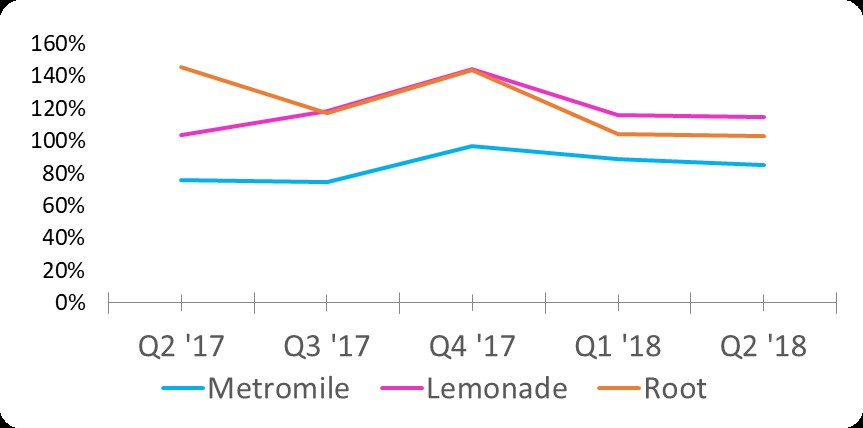
Of the three venture-backed startups, Metromile’s figures have always showed the greatest profitability, and the company shows an improvement on the last quarter, shaving four points off the loss ratio.
- Industry veterans are outperforming the newbies on loss ratio but not premium growth.
Two of the startup carriers sponsored by highly regarded underwriters are performing very well in terms of profit. BiBerk, which ultimately reports to Ajit Jain, recorded a respectable 70 gross loss and LAE ratio in the quarter. Intrepid, where Rob Berkley sits on the board, turned in a 60 loss ratio (without LAE).
Neither company has cracked even $4 million in quarterly premium, compared to Root at nearly $15 million, but is there something that Jain and Berkley know that the newbies don’t? Or are big public companies just less motivated to grow than venture-backed companies?
Is growth first really the right answer?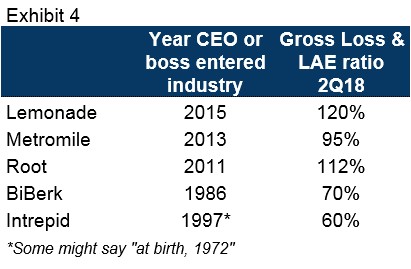
We’re not showing State Farm’s HiRoad entity because we’re less clear on how it reports and is managed by State Farm’s executives.
- Still several years to become a scale insurer.
All three venture-backed insurers increased expenses in the quarter. Root, in particular, lost $11.6 million, a burn rate of $129,000 every day. That still gives two years of runway if the burn rate can be maintained.
We get details on expenditures only in annual statements, so we cannot know for sure whether Root is spending on headcount, advertising or other overhead. LinkedIn pegs the company’s headcount at 117, with 30 people joining just in the second quarter. The company runs a referral program that has paid $860,000 to date. We speculate that $25 is the average referral bonus (so $50, since both parties get the bonus), which equates to 17,000 referrals. If the average premium is $750 (again a guess; a bit below the national average), then the referral program has generated over $13 million of premium, which would be an impressive 40 percent of all the premium in these first 18 months.
As the company expands exponentially to grow into its unicorn valuation, the question for investors is if the company can maintain exponential growth and bring down the loss ratio simultaneously—so growing without raising losses exponentially. It’s a difficult balance. In the meantime, investors added $45 million to the insurance company’s statutory surplus, but because of losses, surplus stands at $43 million at the end of the quarter.
The more meaningful number, in our view, is that Root has recorded $344,000 of favorable development this year—meaning it has decided that estimates of prior-year losses were indeed too high. The company earned $792,000 of premiums in 2017 and stated its losses at Dec. 31, 2017 at $1.33 million for a net loss ratio of 168. If 2017 actual losses were in fact $986,000 as now estimated, then the developed loss ratio would be 124—better, but not greatly changing the overall view of the year, which was small and volatile and hence of limited use to understand the company (but the best any outsider had at the time).
Root also deserves credit for being the only one of the three venture-backed companies to have made conservative loss picks. Lemonade continues to see its reserves be inadequate. The company had $2.1 million of reserves at the start of the year and has seen $245,000 of adverse development this year. Even a more experienced underwriter, Metromile, started the year with nearly $14 million of reserves and has recorded nearly $1.5 million of adverse development.
Stepping back from the noise of quarterly reserving, we still believe that the companies have to prove underwriting quality and do so with sustainable overheads and expenses. There’s still a long journey ahead, but the companies have the resources (in the form of cash at the holding company) to work on the challenge for years to come.
- Reinsurers continue to subsidize losses.
In addition to compiling financial results from statutory reports for three InsurTech carriers, the authors of the accompanying article presented details of an annual Supplemental Compensation Disclosure for Lemonade and Metromile.
“The State of Nebraska will mail the information for all companies that operate in Nebraska to anyone who sends them $80. The hardest part is finding a computer with a CD-ROM drive. This is a sore point among insurers (the disclosure, not the need for a CD-ROM),” Matteo Carbone and Adrian Jones wrote in a longer version of this article published on their LinkedIn pages.
For charts showing salary, options and other compensation for the top eight executives of these two companies, refer to the full article on LinkedIn here or here.
Lemonade continues to hand reinsurers $3.61 of losses for every $1 in premium in the quarter. Root handed reinsurers $1.41 of losses for every $1 in premium. Metromile—as with other metrics—is playing a safer game, and its reinsurers even made a bit of money in the quarter, getting $0.86 of losses for every $1 in premium.
Root disclosed that it changed its reinsurance program, reducing its quota share from 50 percent to 25 percent of premium effective June 1 through the remainder of 2018, meaning it will keep more premium (and losses) and possibly get less capital relief. The company retains a $1 million excess of $100,000 per-risk excess of loss treaty. Terms were not disclosed.
Looking Forward
The third quarter, which includes most of the summer, could be a big one for the companies in our coverage universe.
We are gratified by the increasing focus on insurance fundamentals in InsurTech, and the lofty valuations recently seen in the sector will require satisfying both venture metrics as well as solid insurance fundamentals.
The startups have the time and the resources but a long way to go to climb the Cliffs of Insanity. They are gaining on the incumbents, but will they make it to the top of the cliffs before running out of power?
It’s not inconceivable. Tell us what you think.
The authors are attending the Rendez-Vous de Septembre in Monte Carlo and InsureTech Connect in October, and they welcome comments on social media.
Matteo Carbone and Adrian Jones are the guest editors for the upcoming November/December edition of the Carrier Management print magazine—contributing ideas and content for the “Strategy and Innovation” section of the publication.





















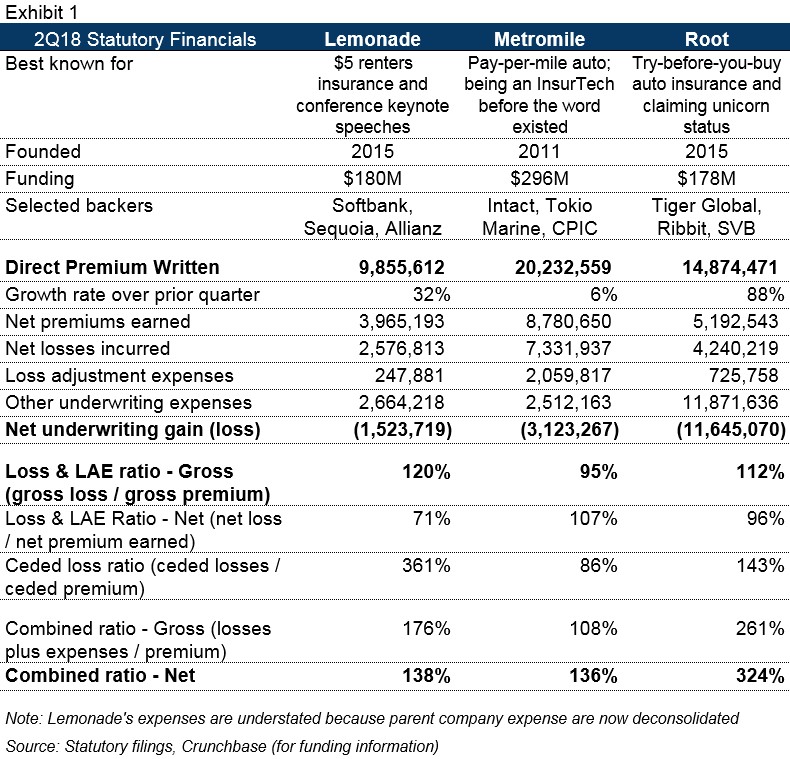
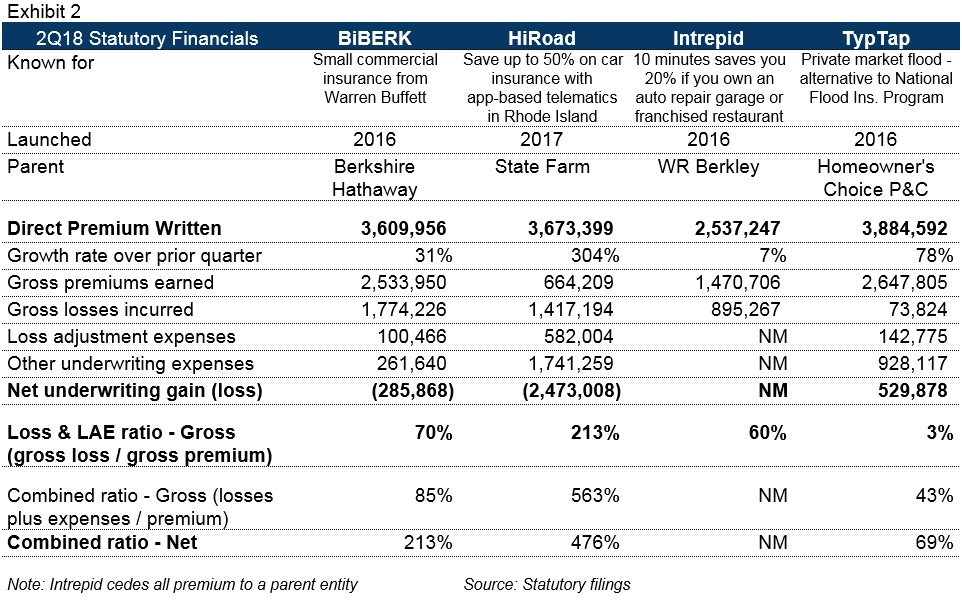
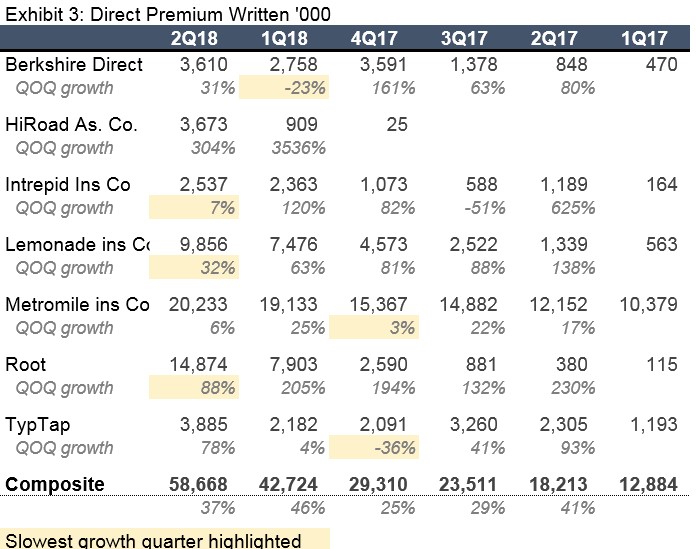

 Carrier Management’s 2025 Top Features (Reader’s Picks Unlocked)
Carrier Management’s 2025 Top Features (Reader’s Picks Unlocked)  Northern California Flooding This Weekend Caused by Heavy Rain, High Tides
Northern California Flooding This Weekend Caused by Heavy Rain, High Tides  What to Expect in 2026: U.S. P/C Results More Like 2024
What to Expect in 2026: U.S. P/C Results More Like 2024  Slideshow: Carrier Management’s 2025 Top Editor’s Picks (Unlocked)
Slideshow: Carrier Management’s 2025 Top Editor’s Picks (Unlocked) 














